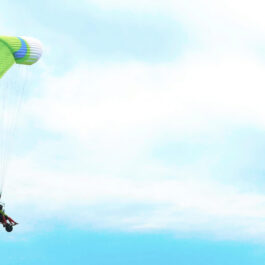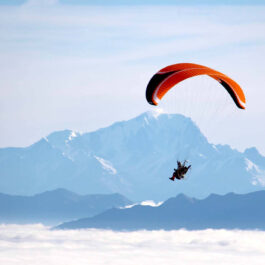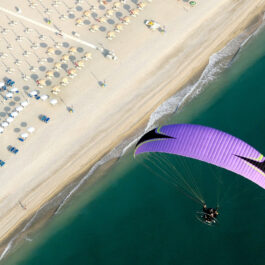NIVIUK Dobermann 2
GET SET, GO!
Speed, efficiency and security in PPG. Discover the new Dobermann 2 and master the challenge of races, slalom courses and aerobatics.
PPG
EN 926-1 / DGAC
Description
Faster, steadier and better in turn
A highly efficient reflex profile is the perfect stability/speed combination. Speed retention assists during all phases of the flight and the wing remains compact and safe throughout the turn. More efficient and effortless than ever.
Huge speed range
Better acceleration efficiency and safety from minimum to top speed. The wing allows quick acceleration to reduce pilot’s lap-time in competitions and slalom courses but it is also good at low speed for an easy control during takeoff and landing.
More sizes
Available and certified in six sizes, suitable for the widest possible range and type of pilots. The new larger sizes are more appropriate for freestyle and recreational flights. The smaller wings are perfect for slalom flying.
Master all your challenges ▼
The Dobermann 2 is an agile and very fast wing, targeted at experienced competition and slalom paramotor pilots, who also want a comfortable and safe glider. It also provides excellent glide efficiency and a wide speed range, which are very valuable characteristics for freestyle and recreational pilots.
Building on the success of the Dobermann, the Niviuk R&D team have worked to improve the speed, handling and ease of turning and stability.
Beginning with speed, the wing’s aerofoil design has been optimised to reach a higher top speed up to 81 km/h*. Furthermore, the Dobermann 2 is fitted with the Double Effect System (DES), allowing pilot to make the most of the glider‘s ability to perform to its maximum potential when using the speed bar. The DES keeps the trimmers in a closed position (slow speed setting) and automatically opens them when accelerating during the flight. When the speed bar is released, the DES returns the profile to the neutral (default) position.
On the other hand, its arched canopy allows a better turning efficiency for improved roll. To enhance the turning efficiency even more, the Dobermann 2 also has the Double Steering System. This means the Dobermann 2’s brake handle has two lines: the main brake and the high-speed tip steering.
The high-speed tip steering allows the pilot to turn without pulling the brake, avoiding profile deformation and hence a decrease in performance and speed. Without yawing, the tip permits a turning speed up to 60 km/h when rounding a pylon.
The high-speed tip steering of the Dobermann 2 can be easily activated and provides the pilot with a simple and efficient tool to turn easily without braking.
Another new feature is the shorter lines to allow the pilot to be closer to the wing, making it possible to obtain a tighter turning radius and effortless handling.
In case of a wingtip collapsing, the very precise stabilo line trimming and its distribution make this part of the glider roll inside instead of folding back for an immediate recovery.
We wanted to add stability and security to all this speed and turn efficiency. The Reflex System Profile (RSP) of the Dobermann 2 was designed to provide sufficient stability without negatively affecting glide or speed. The wing’s optimised profile design enables a perfect combination of control and performances.
The wing also features our RAM Air Intake (RAM). The RAM provides optimised internal pressure for better airflow, which means the glider is more compact at any angle of attack and at all trim settings. It also reduces the risk of a collapse and improves the turbulence buffering ability of the wing.
The use of Nitinol (TNT) offers three major advantages: it helps to reduce the overall weight of the wing, hence inertia is reduced and handling improved; it has shape memory and super-elasticity (the flexible rods always return to their functional optimal shape, therefore no bends, kinks or residual mechanical alterations affect their integrity); and finally, using Nitinol makes the leading edge more robust, so the wing’s surface is perfectly taut, crease-free and without parasitic fabric movements.
Other beneficial features of the Dobermann 2 is the coloured riser design, which on one hand permits easy identification during takeoff and on the other hand the red trim setting indicators assist with symmetrical adjustments. Finally, the changed pulley position, which now can be set in different positions for greater flying comfort.
* Confirmed by Ramón Morillas with a Dobermann 2, size 15 The fabric, lines, risers and wing size can all be changed to customise and adapt the model to suit your needs and preferences. Contact us and we will personally explore all the possibilities.
3D Leading Edge
Adding an extra seam to the leading edge on the span axis of the glider helps to shape a compact 3D profile and have better connections to the new 3DP front panel’s layout.
3D Pattern Cut Optimization
The latest glider generation requires a new pattern design and an optimized fabric cutting process based on a 3D technology.
Double Effect System
With the implementation of the DES pilot can make the most out of the glider’s ability to perform to its full potential using the speed bar.
RAM Air Intake
Evolution and constant improving in all our products is the essence of the DNA of Niviuk’s R&D team. Thanks to the new technologies created over recent years, we have conceived new and more evolved and higher performing gliders. In this context the RAM Air Intake technology should be pointed out.
Reflex System Profile
The highly efficient Reflex System Profile (RSP) unlike conventional reflex designs requires less engine power to achieve greater thrust, thus resulting in lower fuel consumption, more autonomy and higher overall motor efficiency.
Structured Leading Edge
The SLE provides more rigidity and stability along the span of leading edge but also allows full flexibility along the both the vertical and horizontal axis of each open cell. The SLE ensures ease of movement on the ground and high security in the air during turbulence and whilst flying at speed.
Titanium Technology
Constantly innovating, we always are on the hunt, looking for the latest and best materials to helps us design optimal products. For this reason, and after an extensive evaluation of its benefits and qualities, we decided to be the firsts manufacturer to use Nitinol in our glider line.
SPECIFICATIONS
| DOBERMANN2 | 15 | 16 | 17 | 18 | 19 | 20 | ||
| Cells | Number | 60 | 60 | 60 | 60 | 60 | 60 | |
| Closed | 16 | 16 | 16 | 16 | 16 | 16 | ||
| Box | 23 | 23 | 23 | 23 | 23 | 23 | ||
| Flat | Area | m2 | 14.5 | 16 | 17 | 18 | 19 | 20 |
| Span | m | 9.25 | 9.72 | 10.02 | 10.31 | 10.59 | 10.86 | |
| Aspect Ratio | 5.9 | 5.9 | 5.9 | 5.9 | 5.9 | 5.9 | ||
| Projected | Area | m2 | 12.34 | 13.61 | 14.46 | 15.31 | 16.16 | 17.01 |
| Span | m | 7.45 | 7.83 | 8.1 | 8.3 | 8.53 | 8.75 | |
| Aspect Ratio | 4.5 | 4.5 | 4.5 | 4.5 | 4.5 | 4.5 | ||
| Flattening | % | 15 | 15 | 15 | 15 | 15 | 15 | |
| Chord | Maximum | m | 1.91 | 2.01 | 2.07 | 2.13 | 2.19 | 2.24 |
| Minimum | m | 0.46 | 0.48 | 0.5 | 0.51 | 0.53 | 0.54 | |
| Average | m | 1.57 | 1.65 | 1.70 | 1.75 | 1.79 | 1.84 | |
| Lines | Total meters | m | 257 | 271 | 280 | 289 | 297 | 305 |
| Height | m | 5.72 | 6.01 | 6.19 | 6.37 | 6.55 | 6.72 | |
| Number | 178 | 178 | 178 | 178 | 178 | 178 | ||
| Main | 2 1/4/3/1 | 2 1/4/3/1 | 2 1/4/3/1 | 2 1/4/3/1 | 2 1/4/3/1 | 2 1/4/3/1 | ||
| Risers | Number | 4 | A A’/B/C/D | A A’/B/C/D | A A’/B/C/D | A A’/B/C/D | A A’/B/C/D | A A’/B/C/D |
| Trimmers | mm | 150 | 150 | 150 | 150 | 150 | 150 | |
| Accelerator | mm | 180 | 180 | 180 | 180 | 180 | 180 | |
| Course Correction | YES | YES | YES | YES | YES | YES | ||
| Total weight in flight | Minimum | kg | 60 | 65 | 70 | 75 | 80 | 85 |
| Maximum | kg | 95 | 105 | 115 | 125 | 135 | 145 | |
| Glider weight | kg | 3.8 | 4.1 | 4.3 | 4.5 | 4.65 | 4.8 | |
| Certification | 8G max. 148kg | EN 926-1 | EN 926-1 | EN 926-1 | EN 926-1 | EN 926-1 | EN 926-1 | |
| 5,25G max 225kg | DGAC | DGAC | DGAC | DGAC | DGAC | DGAC |
Additional information
| Weight | 50 oz |
|---|---|
| Color | Maya, Emerald |
| Size | 15, 16, 17, 18, 19, 20 |




